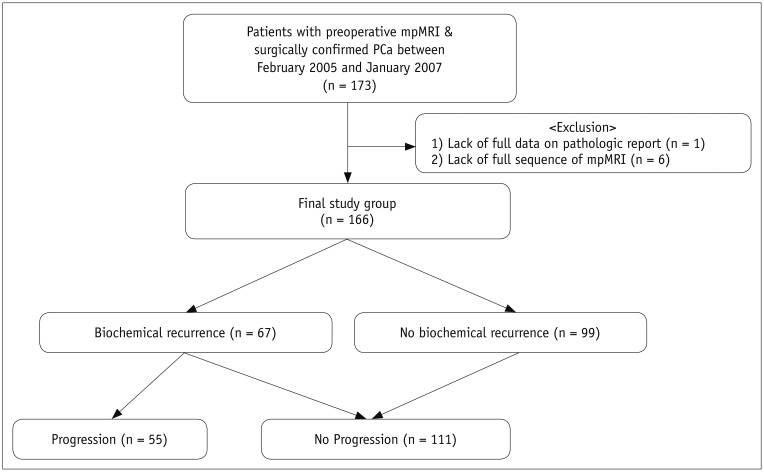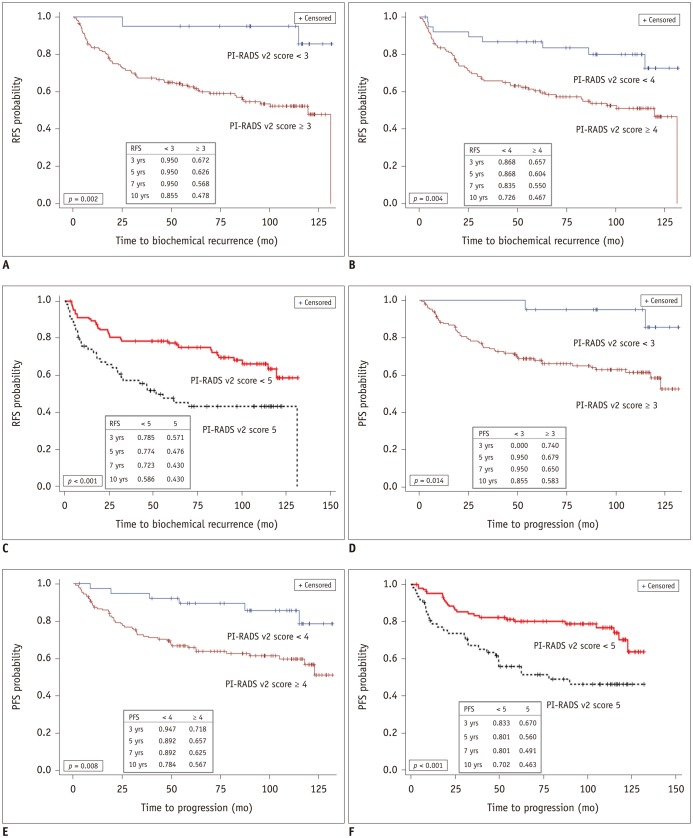Korean J Radiol.
2019 Feb;20(2):256-264. 10.3348/kjr.2018.0613.
Prognostic Significance for Long-Term Outcomes Following Radical Prostatectomy in Men with Prostate Cancer: Evaluation with Prostate Imaging Reporting and Data System Version 2
- Affiliations
-
- 1Department of Radiology and Center for Imaging Science, Samsung Medical Center, Sungkyunkwan University School of Medicine, Seoul, Korea. chankyokim@skku.edu
- 2Department of Radiology, Chungnam National University Hospital, Daejeon, Korea.
- 3Department of Urology, Samsung Medical Center, Sungkyunkwan University School of Medicine, Seoul, Korea.
- 4Department of Medical Device Management and Research, SAIHST, Sungkyunkwan University, Seoul, Korea.
- KMID: 2438256
- DOI: http://doi.org/10.3348/kjr.2018.0613
Abstract
OBJECTIVE
To retrospectively determine whether the use of the Prostate Imaging Reporting and Data System (PI-RADS) version 2 (v2) helps predict long-term outcomes for prostate cancer (PCa) patients following radical prostatectomy (RP).
MATERIALS AND METHODS
A total of 166 patients with localized PCa evaluated with multiparametric magnetic resonance imaging (mpMRI) at 3T before RP were enrolled. Three groups were created based on PI-RADS v2 score used to predict clinical outcomes: group A, ≥ 3; group B, ≥ 4; group C, 5. We calculated biochemical recurrence-free survival (RFS) and progression-free survival (PFS). Cox proportion hazards models were used to identify variables predictive of biochemical recurrence and disease progression.
RESULTS
During a median follow-up of 9.1 years, biochemical recurrence occurred in 67 patients (40.4%) and disease progression occurred in 55 patients (33.1%). In all groups, 10-year RFS and 10-year PFS were significantly lower for PI-RADS scores ≥ 3, ≥ 4 and 5 than for score < 3, < 4 and < 5 (p <0.05), respectively. In multivariate analysis, PI-RADS score ≥ 3 and score 5 were significant independent risk marker for biochemical recurrence (hazard ratio [HR] = 5.58, p = 0.018; HR = 1.75, p = 0.033) and disease progression (HR = 3.99, p = 0.047; HR = 2.31, p = 0.040). Moderate inter-observer agreement was seen for PI-RADS scoring.
CONCLUSION
PI-RADS v2 may be used to predict long-term outcomes following RP in PCa.
Keyword
MeSH Terms
Figure
Reference
-
1. Stephenson AJ, Scardino PT, Eastham JA, Bianco FJ Jr, Dotan ZA, Fearn PA, et al. Preoperative nomogram predicting the 10-year probability of prostate cancer recurrence after radical prostatectomy. J Natl Cancer Inst. 2006; 98:715–717. PMID: 16705126.
Article2. Han M, Partin AW, Pound CR, Epstein JI, Walsh PC. Long-term biochemical disease-free and cancer-specific survival following anatomic radical retropubic prostatectomy. The 15-year Johns Hopkins experience. Urol Clin North Am. 2001; 28:555–565. PMID: 11590814.3. Ward JF, Moul JW. Rising prostate-specific antigen after primary prostate cancer therapy. Nat Clin Pract Urol. 2005; 2:174–182. PMID: 16474760.
Article4. Boorjian SA, Thompson RH, Tollefson MK, Rangel LJ, Bergstralh EJ, Blute ML, et al. Long-term risk of clinical progression after biochemical recurrence following radical prostatectomy: the impact of time from surgery to recurrence. Eur Urol. 2011; 59:893–899. PMID: 21388736.
Article5. Pound CR, Partin AW, Eisenberger MA, Chan DW, Pearson JD, Walsh PC. Natural history of progression after PSA elevation following radical prostatectomy. JAMA. 1999; 281:1591–1597. PMID: 10235151.
Article6. Mehta SS, Lubeck DP, Sadetsky N, Pasta DJ, Carroll PR. Patterns of secondary cancer treatment for biochemical failure following radical prostatectomy: data from CaPSURE. J Urol. 2004; 171:215–219. PMID: 14665879.
Article7. Park JJ, Kim CK, Park SY, Park BK, Lee HM, Cho SW. Prostate cancer: role of pretreatment multiparametric 3-T MRI in predicting biochemical recurrence after radical prostatectomy. AJR Am J Roentgenol. 2014; 202:W459–W465. PMID: 24758681.
Article8. Park SY, Kim CK, Park BK, Lee HM, Lee KS. Prediction of biochemical recurrence following radical prostatectomy in men with prostate cancer by diffusion-weighted magnetic resonance imaging: initial results. Eur Radiol. 2011; 21:1111–1118. PMID: 21046403.
Article9. Weinreb JC, Barentsz JO, Choyke PL, Cornud F, Haider MA, Macura KJ, et al. PI-RADS Prostate Imaging - Reporting and Data System: 2015, version 2. Eur Urol. 2016; 69:16–40. PMID: 26427566.
Article10. Barentsz JO, Richenberg J, Clements R, Choyke P, Verma S, Villeirs G, et al. European Society of Urogenital Radiology. ESUR prostate MR guidelines 2012. Eur Radiol. 2012; 22:746–757. PMID: 22322308.11. Park SY, Oh YT, Jung DC, Cho NH, Choi YD, Rha KH, et al. Prediction of biochemical recurrence after radical prostatectomy with PI-RADS version 2 in prostate cancers: initial results. Eur Radiol. 2016; 26:2502–2509. PMID: 26560721.
Article12. Zhang YD, Wu CJ, Bao ML, Li H, Wang XN, Liu XS, et al. MR-based prognostic nomogram for prostate cancer after radical prostatectomy. J Magn Reson Imaging. 2017; 45:586–596. PMID: 27654116.
Article13. Brockman JA, Alanee S, Vickers AJ, Scardino PT, Wood DP, Kibel AS, et al. Nomogram predicting prostate cancer-specific mortality for men with biochemical recurrence after radical prostatectomy. Eur Urol. 2015; 67:1160–1167. PMID: 25301759.
Article14. Scher HI, Halabi S, Tannock I, Morris M, Sternberg CN, Carducci MA, et al. Design and end points of clinical trials for patients with progressive prostate cancer and castrate levels of testosterone: recommendations of the Prostate Cancer Clinical Trials Working Group. J Clin Oncol. 2008; 26:1148–1159. PMID: 18309951.
Article15. Landis JR, Koch GG. The measurement of observer agreement for categorical data. Biometrics. 1977; 33:159–174. PMID: 843571.
Article16. Woo S, Suh CH, Kim SY, Cho JY, Kim SH. Diagnostic Performance of Prostate Imaging Reporting and Data System version 2 for detection of prostate cancer: a systematic review and diagnostic meta-analysis. Eur Urol. 2017; 72:177–188. PMID: 28196723.
Article17. Egevad L, Granfors T, Karlberg L, Bergh A, Stattin P. Prognostic value of the Gleason score in prostate cancer. BJU Int. 2002; 89:538–542. PMID: 11942960.
Article18. Nketiah G, Elschot M, Kim E, Teruel JR, Scheenen TW, Bathen TF, et al. T2-weighted MRI-derived textural features reflect prostate cancer aggressiveness: preliminary results. Eur Radiol. 2017; 27:3050–3059. PMID: 27975146.
Article19. Kim W, Kim CK, Park JJ, Kim M, Kim JH. Evaluation of extracapsular extension in prostate cancer using qualitative and quantitative multiparametric MRI. J Magn Reson Imaging. 2017; 45:1760–1770. PMID: 27749009.
Article20. Lim CS, McInnes MDF, Lim RS, Breau RH, Flood TA, Krishna S, et al. Prognostic value of Prostate Imaging and Data Reporting System (PI-RADS) v. 2 assessment categories 4 and 5 compared to histopathological outcomes after radical prostatectomy. J Magn Reson Imaging. 2017; 46:257–266. PMID: 27807914.
Article21. Rosenkrantz AB, Ginocchio LA, Cornfeld D, Froemming AT, Gupta RT, Turkbey B, et al. Interobserver reproducibility of the PI-RADS version 2 Lexicon: a multicenter study of six experienced prostate radiologists. Radiology. 2016; 280:793–804. PMID: 27035179.
Article22. Muller BG, Shih JH, Sankineni S, Marko J, Rais-Bahrami S, George AK, et al. Prostate cancer: interobserver agreement and accuracy with the Revised Prostate Imaging Reporting and Data System at multiparametric MR imaging. Radiology. 2015; 277:741–750. PMID: 26098458.
Article23. Glazer DI, Mayo-Smith WW, Sainani NI, Sadow CA, Vangel MG, Tempany CM, et al. Interreader agreement of Prostate Imaging Reporting and Data System version 2 using an in-bore MRI-guided prostate biopsy cohort: a single institution’s initial experience. AJR Am J Roentgenol. 2017; 209:W145–W151. PMID: 28657843.
Article24. Woo S, Cho JY, Ku JH, Kim SY, Kim SH. Prostate cancer-specific mortality after radical prostatectomy: value of preoperative MRI. Acta Radiol. 2016; 57:1006–1013. PMID: 26508791.
Article25. Hamdy FC, Donovan JL, Lane JA, Mason M, Metcalfe C, Holding P, et al. ProtecT Study Group. 10-year outcomes after monitoring, surgery, or radiotherapy for localized prostate cancer. N Engl J Med. 2016; 375:1415–1424. PMID: 27626136.
Article26. Diaz M, Peabody JO, Kapoor V, Sammon J, Rogers CG, Stricker H, et al. Oncologic outcomes at 10 years following robotic radical prostatectomy. Eur Urol. 2015; 67:1168–1176. PMID: 24996687.
Article27. Kwon MR, Kim CK, Kim JH. PI-RADS version 2: evaluation of diffusion-weighted imaging interpretation between b = 1000 and b = 1500 s mm−2. Br J Radiol. 2017; 90:20170438. PMID: 28830221.
- Full Text Links
- Actions
-
Cited
- CITED
-
- Close
- Share
- Similar articles
-
- Radical Prostatectomy
- Prostate Imaging and Reporting and Data System Version 2.1: Limitations for Clinical Use
- A Case of No Residual Cancer in Radical Prostatectomy Specimens Despite Biopsy-proven Prostate Cancer
- Role of Magnetic Resonance Imaging Using Prostate Imaging-Reporting and Data System Version 2 to Predict Clinically Significant Cancer After Radical Prostatectomy in Very Low-Risk or Low-Risk Prostate Cancer
- Review the Treatment Outcome in the Adenocarcinoma of the Prostate



